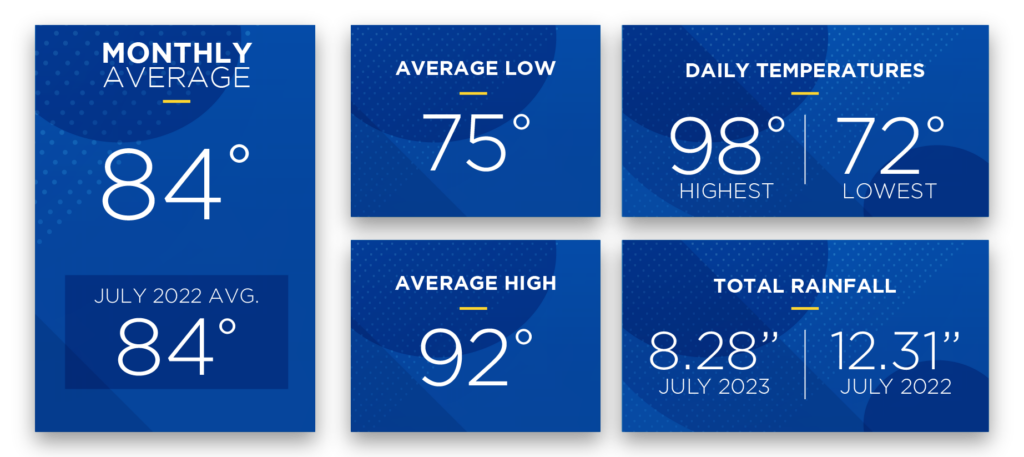July 2023 Sunshine State Stats
In July 2023, both the average high and low temperatures rose from June’s figures. Rainfall increased nearly 24% from the month prior as Central Florida weather continued its steamy path through summer. While tropical storm formation remained quiet, local rain and thunderstorm activity was busy, and measurable precipitation occurred in 17 out of 31 days. After the first five days of July pushed highs at or above 95 degrees with no rain, a seasonal pattern of afternoon storms became more predictable.

While the average temperature for July 2023 was 84 degrees (3 degrees higher than last month’s average), there is no denying that the month was boiling hot. There are claims that this may be the hottest month ever recorded. Heat indices soared to 110 degrees in some parts of Central Florida and even reached the 120-degree mark in South Florida and other states. The average high was 92 degrees, while the average low was 75 degrees.
With steady temperatures in the hot to boiling range, members’ kilowatt-hour (kWh) usage has likely increased as they utilize their HVAC use to combat rising summer temperatures. HVAC is the largest energy user in Central Florida homes – accounting for 35 to 40% of kWh usage on average. Read August SECO News for advice on a summer HVAC tune up.
The highest daily recorded temperature (data from the Leesburg KLEE weather station) in July was 98 degrees and the lowest was 72 – the highest daily recorded temperature in June was 96 degrees and the lowest was 66. July 2023 rainfall totaled 8.28 inches, versus 6.75 inches in June. Precipitation was most active in the second and third weeks.
August forecast from The Old Farmer’s Almanac
Look for isolated showers and scattered thunderstorms throughout the month and 2” lower-than-average rainfall. Temperatures will begin to moderate toward the end of the month resulting in a projected average temperature of 83 degrees.
The Atlantic hurricane season enters its third month, and some storm predictions are shifting. Colorado State University released a mid-season projection that now suggests we may experience an “above-normal season” with 18 named storms, nine of which may become hurricanes, and of those nine, four could becoming major, Category 3,4, 5 storms.
Keep your eyes on the tropics for early signs of disturbances that could strengthen and impact Florida. Now is the time to gather your hurricane/emergency supplies. Review our Hurricane Handbook for a list of supplies, and what actions to take before, during and after a storm. Remember, supplies sell out quickly once a storm is forecast to affect our area.
To check historical usage, log into SmartHub to view past bills and consumption charts. If your usage is high, SECO offers several energy-efficiency tools to help you identify energy wasters. Take the Home Energy Assessment to receive a detailed email tailored to your home’s features and lifestyle. The energy-saving advice will provide low-cost ways to decrease your usage – and your electric bill.
To easily calculate how much energy your appliances, lighting, electronic devices, and other energy-using items in your home consume, use the Energy Estimator.






